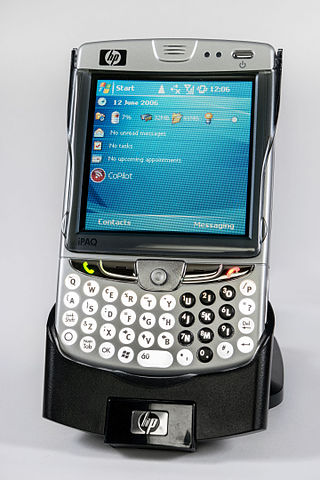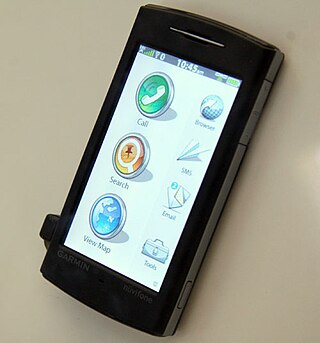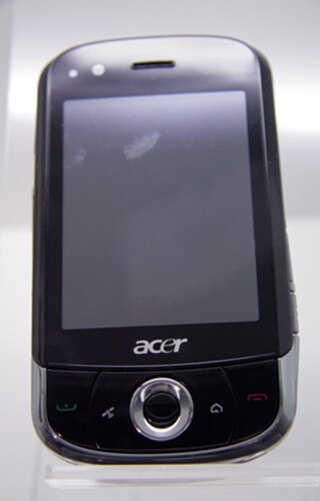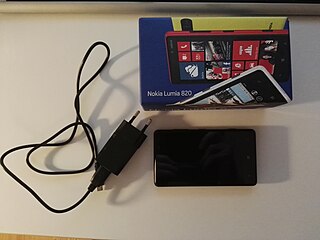
A personal digital assistant (PDA) is a multi-purpose mobile device which functions as a personal information manager. Following a boom in the 1990's and 2000's, PDA's were mostly displaced by the widespread adoption of more highly capable smartphones, in particular those based on iOS and Android in the late 2000's, and thus saw a rapid decline.

A Pocket PC is a class of personal digital assistant (PDA) that runs the Windows Mobile or Windows Embedded Compact operating system that has some of the abilities of modern desktop PCs. The name was introduced by Microsoft in 2000 as a rebranding of the Palm-size PC category. Some of these devices also had integrated phone and data capabilities, which were called Pocket PC Phone Edition. Windows "Smartphone" is another Windows CE based platform for non-touch flip phones or dumber phones.

A smartphone, often simply called a phone, is a mobile device that combines the functionality of a traditional mobile phone with advanced computing capabilities. It typically has a touchscreen interface, allowing users to access a wide range of applications and services, such as web browsing, email, and social media, as well as multimedia playback and streaming. Smartphones have built-in cameras, GPS navigation, and support for various communication methods, including voice calls, text messaging, and internet-based messaging apps.

The iPAQ is a discontinued Pocket PC and personal digital assistant which was first unveiled by Compaq in April 2000.
The Motorola MPx200 smartphone was launched in December 2003 as a joint venture between Motorola and Microsoft. The mobile phone's Windows Mobile for Smartphone OS allows users to access email and the Internet, use MSN Messenger, and view documents in Microsoft Office formats much like other Windows smartphones such as the Samsung SGH-i600 or HTC Tanager. The MPx200, along with the Samsung SCH-i600, were the first Windows Mobile smartphone devices to have wide distribution in the United States. Previously, smartphone platform devices could only be purchased in the United States as part of development kits sold by Microsoft. The only U.S. carrier of the phone was AT&T Wireless; however, reports also suggest a somewhat limited number of devices with Cingular branding have appeared following the purchase of AT&T Wireless by Cingular.

Windows Mobile is a discontinued mobile operating system developed by Microsoft for smartphones and personal digital assistants.
Archos is a French multinational electronics company that was established in 1988 by Henri Crohas. Archos manufactures tablets, smartphones, portable media players and portable data storage devices. The name is an anagram of Crohas' last name. Also, in Greek (-αρχος), it's a suffix used in nouns indicating a person with power. The company's slogan has been updated from "Think Smaller" to "On The Go", and the current "Entertainment your way".

Internet Explorer Mobile was a mobile version of Internet Explorer developed by Microsoft, based on versions of the MSHTML (Trident) layout engine. IE Mobile comes loaded by default with Windows Phone and Windows CE. Later versions of Internet Explorer Mobile are based on the desktop version of Internet Explorer. Older versions however, called Pocket Internet Explorer, are not based on the same layout engine.

The HTC TyTN is an Internet-enabled Windows Mobile Pocket PC PDA designed and marketed by High Tech Computer Corporation of Taiwan. It has a touchscreen with a left-side slide-out QWERTY keyboard. The TyTN's functions include those of a camera phone and a portable media player in addition to text messaging and multimedia messaging. It also offers Internet services such as e-mail, instant messaging, web browsing, and local Wi-Fi connectivity. It is a quad-band GSM phone with GPRS, and EDGE, and a single/dual band UMTS phone with HSDPA. It is a part of the first line of PDAs directly marketed and sold by HTC. On AT&T/Cingular, the TyTN was the successor to the HTC Wizard, known as the Cingular 8125. Also on AT&T, the TyTN was superseded by the HTC TyTN II, known as the AT&T 8925 and the AT&T Tilt.

The HTC TyTN II is an Internet-enabled Windows Mobile Pocket PC smartphone designed and marketed by HTC Corporation of Taiwan. It has a tilting touchscreen with a right-side slide-out QWERTY keyboard. The TyTN II's functions include those of a camera phone and a portable media player in addition to text messaging and multimedia messaging. It also offers Internet services including e-mail, instant messaging, web browsing, and local Wi-Fi connectivity. It is a quad-band GSM phone with GPRS, EDGE, UMTS, HSDPA, and HSUPA.

The Garmin Nüvifone is a discontinued line of Internet-enabled mobile phone and personal navigation devices manufactured by a partnership between Garmin and Asus. It makes use of a touchscreen with virtual keyboards and buttons.

The HTC Touch Pro2 is a slate smartphone, part of the Touch series of Internet-enabled, Windows Mobile, Pocket PC smartphones designed and marketed by HTC Corporation of Taiwan. It is an enhanced version of the HTC Touch Pro with a left-side slide-out QWERTY keyboard, with tilting screen. The Touch Pro2 smartphone's functions include those of a camera phone and a portable media player in addition to text messaging and multimedia messaging. It also offers Internet services including e-mail, instant messaging, web browsing, and local Wi-Fi connectivity. Visual voicemail is not a standard feature for the Touch Pro2, unlike its predecessor the Touch Pro. The Verizon Wireless version does include a visual voicemail application, however. All versions feature TouchFLO 3D — a new enhanced version of the TouchFLO interface, unique only to the latest Touch series. The latest update renamed TouchFLO 3D to SenseUI, to match HTC's Android offering. The Touch Pro2 — along with its sister model, the Touch Diamond2 — were unveiled on February 16, 2009 in Barcelona, Spain at the Mobile World Congress 2009. Specific enhancements over the original Touch Pro include:
The Toshiba TG01 is a large touchscreen phone/Mobile Internet Device. It is based on the Windows Mobile operating system and uses Qualcomm Snapdragon chip architecture (QSD8250), rated at 1 GHz. Connectivity-wise, it is a quad-band GSM phone with support for 2100 MHz UMTS with HSDPA download speeds of up to 7.2 Mbit/s and HSUPA upload speeds of up to 2 Mbit/s. It is Wi-Fi capable, GPS-enabled with support for A-GPS, and comes with Bluetooth 2.0, microSD expandable memory and a micro USB connector.

Samsung GT-i8910 Omnia HD is a smartphone manufactured by Samsung Electronics, first announced at MWC 2009 on February 18, 2009. The device was the first phone capable of playing and recording 720p HD video. It runs on the S60 5th Edition (Symbian^1) platform, the only Samsung device to do so.
The Samsung SGH-i907, marketed as the Samsung Epix in the United States by AT&T Wireless, is a Windows Mobile-based quad-band GSM smartphone manufactured by Samsung.

The Samsung GT-I7500 Galaxy is a smartphone manufactured by Samsung that uses the open source Android operating system. It was announced on 27 April 2009 and was released on 29 June 2009 as the first Samsung Mobile device to use the Android operating system introduced in the HTC Dream, and the first in what would become the long-running Galaxy series. It was succeeded by the Samsung Galaxy S in 2010.
The Acer DX900 is the lead device in the company’s range of five mobile phones, labeled the Acer Tempo Smartphone Series. It was announced at the Mobile World Congress during February 2009.

Announced at the Mobile World Congress during February 2009, the X960 is one of Acer’s first five mobile phones, labelled the Acer Tempo Smartphone Series.
This is a list of smartphones manufactured by Acer. They either run Android or Windows Mobile.

The Nokia Lumia 820 is a smartphone designed, developed and marketed by Nokia. It is the successor to the Lumia 800 and is one of the first Nokia phones to implement Windows Phone 8 alongside the Nokia Lumia 920. Although sharing a similar appearance with the Lumia 800, the Lumia 820 is a major overhaul over its predecessor, sporting a 4.3 inches (110 mm) diagonal OLED display with scratch resistant glass, though lacking Gorilla Glass protection, 1.5 GHz dual-core processor, and an 8.7-megapixel camera. The phone will come with LTE connectivity and a wireless-charging option. The 820 is the first Nokia Windows Phone OS based smartphone to embed a microSD card slot.












